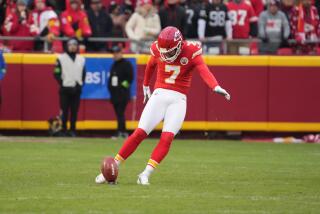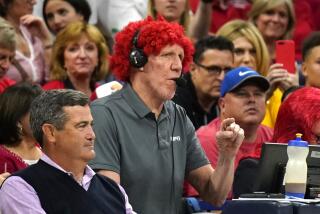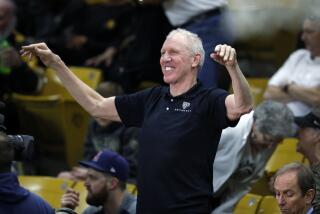Slamming the Dunk : Steitz Would Like to See Basket Raised at Least 1 1/2 Feet
SPRINGFIELD, Mass. — Sitting amid the wall-to-wall plaques, photos, and miscellaneous memorabilia collected in his Springfield College office, director of athletics Edward Steitz strikes one as an amiable, reasonable, and thoughtful person.
So why does he want to turn basketball on its ear?
As editor and interpreter of men’s basketball rules for the National Collegiate Athletic Assn., Dr. Steitz has long wanted to raise the hoop from its present 10 feet to a lofty 11 1/2 or 12 feet--out of slam-dunk range.
To some, that’s poppycock. To Steitz, it’s returning to one of the game’s original principles: that the ball should be shot, not dropped, into the basket.
“I’m not ‘anti-dunk,”’ he says. “If I were, I certainly wouldn’t have led the movement to reinstitute the dunk into the collegiate game,” he says in a deep, resonant voice. “Sure, it’s a beautiful sight to see a six-footer dunk. That’s a pretty good skill. But . . . it’s not a big deal when a seven-footer takes the ball and thrusts it down through the basket along with his elbow.”
College coaches contacted support Steitz’s principle, but not his numbers. Raising the basket two feet would “really endanger the mechanics of the shot,” says Arizona State head coach Steve Patterson. Experiment with a 3- or 6-inch change, he suggests. “You could raise it gradually, as the talent pool rises, to keep the dunking still challenging, but not eliminate it completely.”
Louisville’s assistant coach Jerry Jones agrees: “If kids can jump higher, let’s lift it up six inches.” But two feet? “That’s way out of kilter.”
Steitz is keenly aware of the game’s roots. The sport was invented by Dr. James Naismith on the Springfield campus in 1891, and the international Basketball Hall of Fame (where Steitz was enshrined as a “contributor” six years ago) is downtown. Unavoidably, Steitz is seen to some degree as the guardian of the Naismith tradition.
A varsity baseball player at Cornell University, Steitz had been on a career track to become a veterinarian. But after coming out of the Army at the end of World War II, he decided he’d rather work with people. He pursued graduate degrees in education and physical education at Springfield.
He joined the school’s faculty in 1948, and was asked to assist noted basketball coach John Bunn, who was also the editor and national interpreter for the basketball rules committee. Steitz was groomed as Bunn’s successor for the latter job as well. He’s held the post since 1967.
The 12-member rules committee largely consists of active coaches, elected for a maximum of six years. The secretary-editor, who can be elected to a lifetime of three-year terms, provides continuity and perspective, and wields a fair amount of influence. IN fact, Steitz is generally regarded as the father of the controversial three-point basket, which he calls the “home run of basketball.” The three-pointer was not a novel idea when adopted two years ago; the National Basketball Association has had its own version since 1979. But many felt the NCAA’s 19 feet 9 inch distance (4 feet closer than the NBA’s), was too easy.
Instead of ruining the game, though, the rule has added excitement by encouraging three-point attempts for a full 40 minutes, instead of just in the waning moments. Long-range marksmen must be guarded, easing congestion near the basket, and prompting more crowd-pleasing drives to the hoop.
The success of the three-pointer is no surprise to Steitz, who points out that radical changes aren’t made without significant research. In the case of the three-pointer, various conference experiments with it over the course of five seasons yielded opinions showing that 19-9 was the ideal distance.
Conferences must be found that will voluntarily try out possible new rules. Many stepped forward to test shot clocks, ultimately leading to the adoption of a 45-second timer in 1985.
This season, though, there were no takers for experiments sanctioned by the rules committee: using wider free-throw lanes (either the NBA or international, fan-shaped varieties), and rewarding three shots to players fouled in the act of three-point attempts.
No group has ever volunteered to be a guinea pig for a higher basket, although the Big Ten Conference nearly took the plunge two decades ago. The coaches vetoed the idea when they realized no team forced to switch back to a regulation basket during the NCAA’s nationwide playoffs stood much of a chance.
The increasing importance of the national tournament, both in money and prestige, has made coaches even more reluctant to accept experiments with the rules, Steitz says. “Coaches resist change,” he observes. “They may have won a championship under the past code of rules and (changing) means different coaching tactics have to come into play.
“You should have heard the hue and cry in 1938-39, when the center jump (after every basket) was eliminated,” he says. “People said, ‘What are you trying to do, make a track meet out of this game?’ It proved to be one of the greatest changes the rules committee ever made.”
Whether the 12-foot basket is a similar breakthrough is another question. But with the court dimensions locked in by arena seating configurations, Steitz figures the only way to expand is up. “It may not happen in my lifetime,” he predicts, “but in 2020 the basket will have been moved up.”
Evolution of College Basketball Rules
--1891: Dr. James Naismith, an instructor at a YMCA training school (now Springfield College), invents basketball as an indoor winter sport. There were 18 students in his class, so there were nine players per side. A soccer ball was used.
--1893: Backboards introduced to protect ball from spectator interference.
--1894: Free throws introduced. Free throw line moved from 20 to 15 feet.
--1895: Field goals changed from 3 to 2 points; free throws from 3 points to 1.
--1909: Glass backboards approved. Players disqualified after committing 4 fouls.
--1929: Use of rope or chicken wire to enclose the court discontinued.
--1937: Center court jump-off after each score eliminated.
--1944: Unlimited substitution permitted; limit increased to 5 personal fouls before disqualification; defenders prohibited from touching descending shots (goaltending).
--1967: Dunk shots banned.
--1976: Dunks re-legalized.
--1981: Jump balls limited to beginning of game and overtimes.
--1985: 45-second shot clock adopted (no timer before).
--1986: Baskets from 19 feet and beyond count 3 points.
More to Read
Go beyond the scoreboard
Get the latest on L.A.'s teams in the daily Sports Report newsletter.
You may occasionally receive promotional content from the Los Angeles Times.









